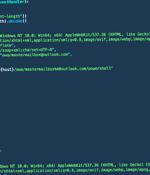Security News

The first is a Microsoft Exchange elevation of privileges bug tracked as CVE-2022-41080 that can be chained with the CVE-2022-41082 ProxyNotShell bug to gain remote code execution. Texas-based cloud computing provider Rackspace confirmed one week ago that the Play ransomware gang exploited it as a zero-day to bypass Microsoft's ProxyNotShell URL rewrite mitigations and escalate permissions on compromised Exchange servers.

More than 60,000 Microsoft Exchange servers exposed online are yet to be patched against the CVE-2022-41082 remote code execution (RCE) vulnerability, one of the two security flaws targeted by...

Reports this week illustrate how threat actors consider Microsoft Exchange as a prime target for gaining initial access to corporate networks to steal data and deploy ransomware. CrowdStrike researchers reported this week that the Play ransomware operation utilized a new Microsoft Exchange attack dubbed 'OWASSRF' that chained exploits for CVE-2022-41082 and CVE-2022-41080 to gain initial access to corporate networks.

The notorious FIN7 hacking group uses an automated attack system that exploits Microsoft Exchange and SQL injection vulnerabilities to breach corporate networks, steal data, and select targets for ransomware attacks based on financial size. Next, FIN7's internal 'marketing' team scrutinizes new entries and adds comments on the Checkmarks platform to list victims' current revenue, number of employees, domain, headquarters details, and other information that helps pentesters determine if the firm is worth the time and effort of a ransomware attack.

Ransomware-wielding attackers are using a new exploit chain that includes one of the ProxyNotShell vulnerabilities to achieve remote code execution on Microsoft Exchange servers.The ProxyNotShell exploit chain used CVE-2022-41040, a SSRF vulnerability in the Autodiscover endpoint of Microsoft Exchange, while this new one uses CVE-2022-41080 to achieve privilege escalation through Outlook Web Access.

An Android banking malware named 'Godfather' has been targeting users in 16 countries, attempting to steal account credentials for over 400 online banking sites and cryptocurrency exchanges. The malware generates login screens overlaid on top of the banking and crypto exchange apps' login forms when victims attempt to log in to the site, tricking the user into entering their credentials on well-crafted HTML phishing pages.

Threat actors affiliated with a ransomware strain known as Play are leveraging a never-before-seen exploit chain that bypasses blocking rules for ProxyNotShell flaws in Microsoft Exchange Server to achieve remote code execution through Outlook Web Access. "The new exploit method bypasses URL rewrite mitigations for the Autodiscover endpoint," CrowdStrike researchers Brian Pitchford, Erik Iker, and Nicolas Zilio said in a technical write-up published Tuesday.

Play ransomware threat actors are using a new exploit chain that bypasses ProxyNotShell URL rewrite mitigations to gain remote code execution on vulnerable servers through Outlook Web Access. Cybersecurity firm CrowdStrike spotted the exploit while investigating Play ransomware attacks where compromised Microsoft Exchange servers were used to infiltrate the victims' networks.

Microsoft warned today that it will permanently turn off Exchange Online basic authentication starting early January 2023 to improve security. "Beginning in early January, we will send Message Center posts to affected tenants about 7 days before we make the configuration change to permanently disable Basic auth use for protocols in scope," The Exchange Team said on Tuesday.

Rackspace has finally confirmed the cause of the ongoing outage of its Hosted Exchange service: it's ransomware. "As you know, on Friday, December 2nd, 2022, we became aware of suspicious activity and immediately took proactive measures to isolate the Hosted Exchange environment to contain the incident. We have since determined this suspicious activity was the result of a ransomware incident," the company stated in the newest released service announcement.